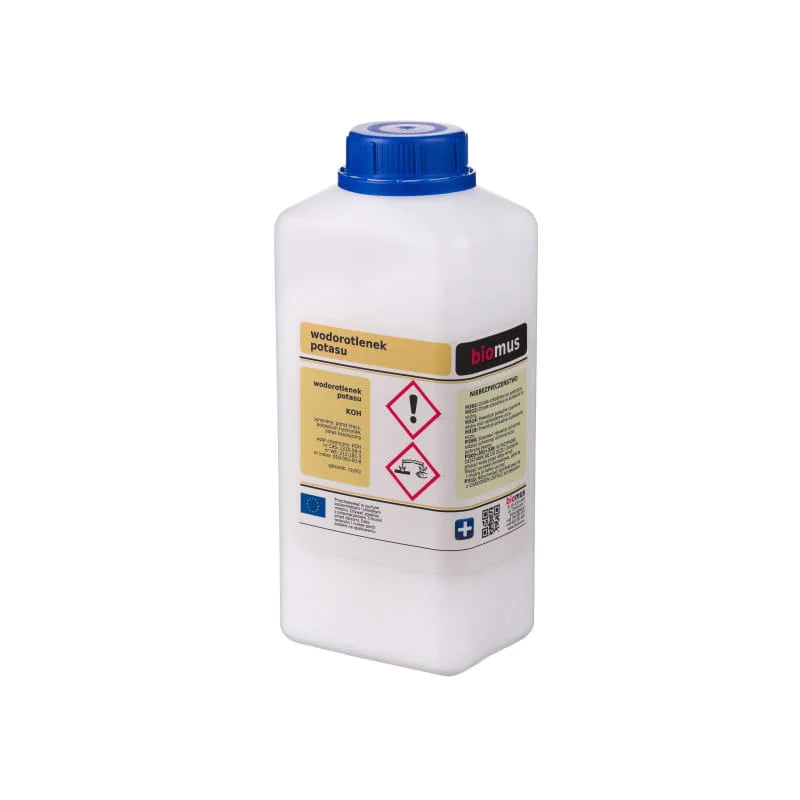Potassium hydroxide 1000g BIOMUS
- Regular price
- €9,82
- Regular price
-
- Sale price
- €9,82
- Unit price
- per
Couldn't load pickup availability
Description
xPotassium hydroxide (caustic potash), KOH - an inorganic chemical compound from the group of hydroxides, one of the strongest bases. Under normal conditions, potassium hydroxide is a white solid. As a chemical reagent, it is usually produced in the form of brittle, crystalline, soft flakes or granules with a water content of around 15%. It has strong hygroscopic properties, greater than sodium hydroxide. It dissolves very well in water; the dissolution process is strongly exothermic. The solution, known as caustic soda, is strongly alkaline. Potassium hydroxide and its water solution absorb carbon dioxide from the air to form potassium carbonate, so it should be stored in airtight containers. It is highly corrosive and can cause severe burns. If swallowed, it causes burns in the esophagus and stomach, can cause its perforation.
specification
Name: Potassium Hydroxide
Synonyms: caustic potash, caustic potash, potassium hydroxide
Species: clean
Purity: at least 90%
Chemical formula: KOH Application
• drying and bleaching agents,
• absorption of carbon dioxide,
• HHO - perfect for HHO hydrogen generators,
• strong base in chemistry,
• extraction of other potassium compounds (e.g. potassium salts),
• production of soft potash soaps,
• production of matrices in lithography,
• Electrolytes (e.g. in nickel-cadmium batteries),
• decomposition of the human body into the resomation process,
• an aqueous 5% potassium hydroxide solution is used to identify rhubarb fluff (the pores of the fungus turn purple),
• the texturing of silicon wafers.
similar products
- Regular price
- €9,82
- Regular price
-
- Sale price
- €9,82
- Unit price
- per
- Regular price
- €9,82
- Regular price
-
- Sale price
- €9,82
- Unit price
- per
- Regular price
- €9,82
- Regular price
-
- Sale price
- €9,82
- Unit price
- per
- Regular price
- €9,82
- Regular price
-
- Sale price
- €9,82
- Unit price
- per
- Regular price
- €9,82
- Regular price
-
- Sale price
- €9,82
- Unit price
- per
- Regular price
- €9,82
- Regular price
-
- Sale price
- €9,82
- Unit price
- per
- Regular price
- €9,82
- Regular price
-
- Sale price
- €9,82
- Unit price
- per
- Regular price
- €9,82
- Regular price
-
- Sale price
- €9,82
- Unit price
- per
- Regular price
- €9,82
- Regular price
-
- Sale price
- €9,82
- Unit price
- per
- Regular price
- €9,82
- Regular price
-
- Sale price
- €9,82
- Unit price
- per
Recently Viewed Products
- Regular price
- €9,82
- Regular price
-
- Sale price
- €9,82
- Unit price
- per
- Regular price
- €9,82
- Regular price
-
- Sale price
- €9,82
- Unit price
- per
- Regular price
- €9,82
- Regular price
-
- Sale price
- €9,82
- Unit price
- per
- Regular price
- €9,82
- Regular price
-
- Sale price
- €9,82
- Unit price
- per
- Regular price
- €9,82
- Regular price
-
- Sale price
- €9,82
- Unit price
- per
- Regular price
- €9,82
- Regular price
-
- Sale price
- €9,82
- Unit price
- per
- Regular price
- €9,82
- Regular price
-
- Sale price
- €9,82
- Unit price
- per
- Regular price
- €9,82
- Regular price
-
- Sale price
- €9,82
- Unit price
- per
- Regular price
- €9,82
- Regular price
-
- Sale price
- €9,82
- Unit price
- per
- Regular price
- €9,82
- Regular price
-
- Sale price
- €9,82
- Unit price
- per
- Choosing a selection results in a full page refresh.















